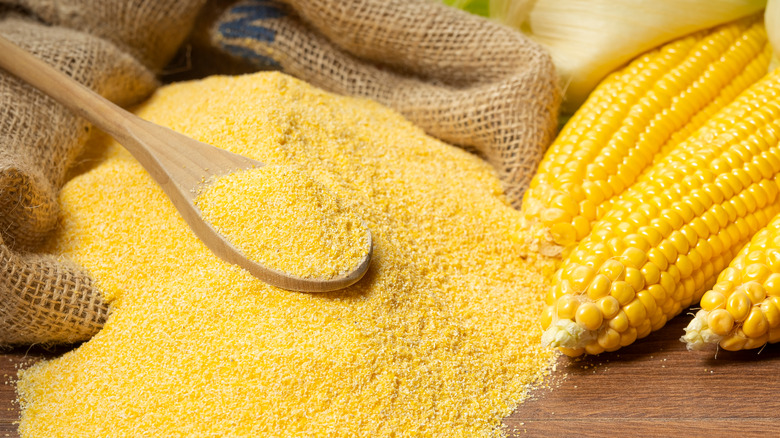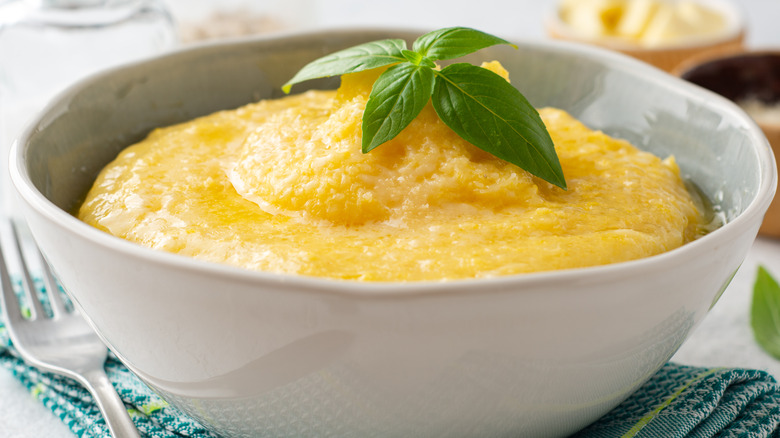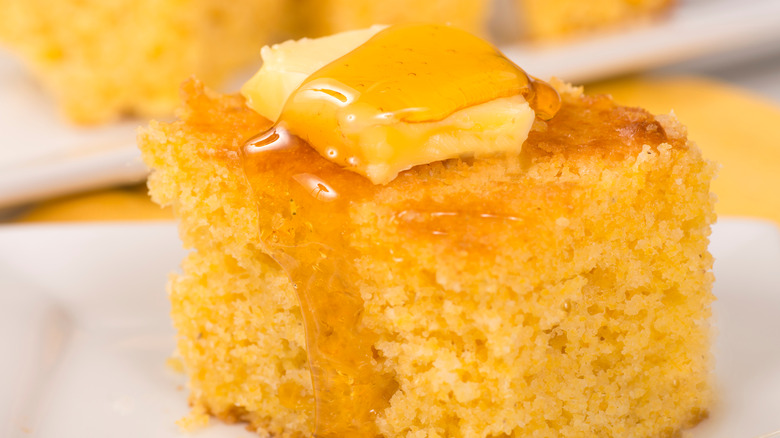What's The Difference Between Polenta And Cornmeal?
Corn is a versatile kitchen staple known for its fresh, bright color and ability to added in various dishes whether it's grilled, popped, sautéed, and even baked. And even more specifically, it can be made into a smooth polenta or ground as cornmeal to make for some satisfying meals. These two are filled with vitamins, minerals, and antioxidants and are the perfect must-have additions to a dinner party or barbecue.
The flavor of corn creates a base that is easily made into a sweet or spicy dish, and the variations in dried ground corn are common alternatives to other flours and starches. Try overnight polenta porridge in place of overnight oats, or substitute cornmeal for traditional wheat flour for a gluten-free alternative.
Although polenta and cornmeal are both stored in your pantry and may appear to be used interchangeably, they have distinct qualities to consider that go beyond the traditional cornbread recipe. Determining which to use and when will depend on the consistency and flavor needed for your favorite dish or baked goods.
What is polenta?
Polenta, hailing from Italy, is traditionally a standalone dish. The coarsely ground yellow corn can be found in the rice aisle of your grocery store. It absorbs flavors as it cooks, creating sweet, spicy, and savory dishes. As Healthline discusses, polenta is rich in antioxidants and can be made high in fiber, making it more easily digested for some.
Freshly prepared, polenta is much like porridge and can be served for breakfast, topped with fresh fruit, cinnamon, and maple syrup. For a side dish, add garlic and red pepper flakes to your polenta and top with roasted vegetables, braised veal, or cajun chicken.
Creating a deliciously creamy, slow-cooked bowl of polenta on the stovetop is simple. The most commonly used liquids are water, chicken broth, and milk. Measure one part polenta to four parts liquid and simmer until it reaches a mushy consistency, about 30 minutes. You can add butter, salt, spices, and even cheese to the pot. Eat your polenta hot topped with berries and cream or roasted tomatoes and balsamic vinegar.
Leftover polenta can be poured onto a wooden board and left to cool. It becomes like bread and can be sliced into wedges you can dip into pesto or top with strawberry jam.
What is cornmeal?
Cornmeal comes from a variety of corn with a robust corn flavor. White cornmeal, the most decadent tasting and least sweet, is used in recipes like homemade tortillas. Yellow cornmeal is a bit sweeter, creating a unique flavor when coating fried foods. For a traditional cornbread recipe or baked dessert, blue cornmeal is the sweetest tasting and adds a nutty flavor.
Coarse cornmeal is ideal for coating fried catfish or in a topping on a blueberry or apple crisp. The finely ground cornmeal is better suited for your pancake, bread, and desserts like cornbread ice cream sandwiches.
To add a slightly nutty, earthy flavor to your next recipe, experiment with partially replacing your wheat or bread flour with finely ground cornmeal measured by weight. The texture of your cake or bread will be similar to the original recipe; however, fully replacing the flour with cornmeal will not allow the same rise and may make your recipe dense. This is the most desirable result in pound cake, scones, or a waffle recipe. You can even use cornmeal as a thickening agent in your chess pie, tarts, and dessert fillings to create a stable custard-like consistency.


